Complete Guide to WAEC Registration and Examination in Nigeria

Introduction
The West African Examinations Council (WAEC) remains a cornerstone of academic assessment in Nigeria and across Anglophone West Africa. For decades, it has provided standardized testing essential for academic progression, employment opportunities, and scholarship pursuits. This complete guide offers a detailed explanation of WAEC, its structure, registration procedures, requirements, examination preparation strategies, and key updates for candidates, parents, teachers, and education consultants in Nigeria.
Understanding WAEC: Background and Functions
What is WAEC?
Established in 1952 by an ordinance in the Gold Coast (now Ghana), the West African Examinations Council is an international examination body mandated to organize, administer, and regulate public examinations in English-speaking West African countries. The founding members include Nigeria, Ghana, Sierra Leone, Liberia, and The Gambia.
Functions of WAEC
- Conduct Examinations: Organise the West African Senior School Certificate Examination (WASSCE) and other international assessments.
- Issue Certificates: Award certificates equivalent to those of examining authorities internationally.
- Develop Educational Assessment Standards: Enhance examination standards and practices across West Africa.
- Conduct Research: Innovate assessment models, grading standards, and educational development strategies.
WAEC certificates are recognized globally, enabling candidates to further their education both locally and internationally.
Types of WAEC Examinations in Nigeria
WAEC conducts different categories of examinations to cater to diverse groups of candidates:
1. WASSCE for School Candidates (May/June)
- Popularly known as May/June WAEC.
- Intended for SS3 students in secondary schools.
- Registration is done collectively by schools under strict guidelines.
- Compulsory for obtaining the Senior Secondary Certificate, a prerequisite for university admission.
2. WASSCE for Private Candidates (GCE – January/February and November/December)
- Also referred to as WAEC GCE.
- Designed for external candidates who are not in school, or for those retaking to improve grades.
- Conducted twice annually:
- First Series (Jan/Feb) – Introduced recently for early retakes.
- Second Series (Nov/Dec) – Traditional GCE period in Nigeria.
- Registration is done individually via the WAEC registration portal.
3. Other WAEC Examinations
- BECE (Basic Education Certificate Examination): For junior secondary school students.
- Professional and International Exams: Such as City & Guilds and examinations in collaboration with international bodies.
WAEC Registration Process: Step by Step
A. Registration for School Candidates
- Notification from School Management:
- Schools announce registration timelines based on WAEC directives.
- Payment of Registration Fees:
- Fees are paid to the school, which remits to WAEC through banks or online platforms.
- Data Capturing:
- Schools upload students’ biodata, passport photographs, and subject combinations on the WAEC online portal.
- Biometric Capture:
- Fingerprint capturing is compulsory to eliminate impersonation.
- Confirmation and Validation:
- Students crosscheck registered subjects and personal details before final submission.
- Printing of Photocards:
- After successful registration, examination photo cards and timetables are printed for each student.
B. Registration for Private Candidates (GCE)
- Obtain Registration PIN:
- Purchase the WAEC e-PIN from designated banks or WAEC offices nationwide.
- Visit the Official WAEC Registration Portal:
- Go to waecdirect.org.
- Create Profile and Input Details:
- Enter your personal information including:
- Full Name (must match official ID or birth certificate)
- Date of Birth
- Gender
- State and LGA of Origin
- Nationality
- Contact Address and Phone Number
- Enter your personal information including:
- Upload Passport Photograph:
- Must be in JPEG format, not more than 15kb, with a plain background.
- Biometric Fingerprint Capture:
- Use WAEC biometric software to validate identity. Centres usually assist candidates in completing this process.
- Select Examination Centre and Subjects:
- Choose a convenient centre and confirm chosen subjects (minimum of eight and maximum of nine, including core subjects).
- Print Photo Card and Timetable:
- Contains examination number, centre, subjects registered, and dates.
Note: Late registration attracts extra charges and may close approximately 3-4 weeks before examination commencement.
WAEC Registration Requirements
- Full Name: As it appears on official documents.
- Date of Birth: Confirm accuracy to avoid future discrepancies.
- Valid Email and Phone Number: For receiving updates and result notifications.
- Passport Photograph: Recent, coloured, with a clear view of the face.
- Biometric Data: Fingerprints are compulsory for validation and examination entry.
- Subject Selection: Candidates must include:
- Compulsory Subjects: English Language, Mathematics, Civic Education.
- Core Subjects: Based on Arts, Science, or Commercial class streams.
WAEC Examination Timetable
WAEC releases its official timetable weeks before the examination to enable adequate preparation. Candidates can access the timetable through:
- School management for May/June candidates.
- The official WAEC portal for GCE candidates.
- Credible educational websites for PDF downloads.
- Newspapers and educational news platforms for summarized versions.
Important Tip: Always crosscheck with your photo card timetable to avoid misinformation.
WAEC Examination Format and Structure
1. Objective Questions
- Multiple-choice questions testing broad knowledge coverage.
2. Theory (Essay) Questions
- Requires detailed written answers, explanations, and calculations where applicable.
3. Practical Examinations
- For Science subjects (Biology, Chemistry, Physics), Food and Nutrition, and vocational subjects.
- Conducted in school or designated centres with laboratory facilities.
4. Oral Tests
- For languages such as French.
Candidates are advised to study WAEC syllabus for each subject to understand topic coverage and examination expectations.
WAEC Grading System
WAEC grades candidates as follows:
| Grade | Interpretation | Score Range (%) |
|---|---|---|
| A1 | Excellent | 75 – 100 |
| B2 | Very Good | 70 – 74 |
| B3 | Good | 65 – 69 |
| C4 | Credit | 60 – 64 |
| C5 | Credit | 55 – 59 |
| C6 | Credit | 50 – 54 |
| D7 | Pass | 45 – 49 |
| E8 | Pass | 40 – 44 |
| F9 | Fail | 0 – 39 |
Note: Minimum requirement for university admission is five credits, including English Language and Mathematics.
How to Check WAEC Results
- Visit www.waecdirect.org.
- Enter your 10-digit examination number.
- Select examination year and type.
- Input your e-PIN voucher number and serial number.
- Click Submit to view results.
- Print and save your result for record-keeping and admission applications.
Common Issues Faced During WAEC Registration and Solutions
| Issue | Cause | Solution |
|---|---|---|
| Mismatch of Names | Typographical errors or inconsistent documents. | Crosscheck all documents before registration; apply for correction via WAEC office if detected early. |
| Biometric Data Rejection | Poor fingerprint capture. | Ensure fingers are clean; visit accredited biometric centres. |
| Subject Registration Errors | Wrong subject combinations. | Confirm subject requirements for intended university courses before final submission. |
| Late Registration | Failure to meet deadlines. | Monitor WAEC announcements; register early to avoid late fees or exclusion. |
WAEC Preparation Tips for Excellent Performance
1. Start Early
Begin studying topics from SS1 to SS3 as WAEC covers entire secondary education syllabuses.
2. Use WAEC Past Questions
Practise at least 10 years of past questions to familiarize yourself with patterns and timing.
3. Create a Study Timetable
Allocate daily study hours for each subject and revise weekly.
4. Attend Tutorials
Join credible WAEC tutorial centres for structured learning and mock examinations.
5. Focus on Weak Subjects
Identify and intensify efforts on difficult subjects to balance your overall performance.
6. Avoid Examination Malpractice
Prepare diligently to avoid dependence on malpractice, which can result in disqualification and legal action.
WAEC Examination Day Guidelines
- Arrive at least 30 minutes before the scheduled time.
- Go with your photo card and necessary writing materials only.
- Listen attentively to invigilators’ instructions.
- Maintain examination ethics and avoid any misconduct.
- Write legibly and manage your time effectively across all questions.
Recent Updates from WAEC Nigeria
- WAEC introduced CBT (Computer-Based Test) pilot examinations for selected subjects, with plans to integrate more CBT assessments in the future.
- New biometric verification systems have been deployed to curb impersonation and malpractice.
- Candidates can now request WAEC digital certificates online for faster processing in scholarship and visa applications.
Conclusion
WAEC remains an integral part of the Nigerian education system, determining students’ academic progression to universities, polytechnics, and colleges of education. Early registration, proper documentation, strategic preparation, and adherence to examination guidelines guarantee success.
For timely updates on WAEC registration deadlines, syllabus summaries, past questions, and educational insights, visit myschoolinsight.com regularly.




One Comment